Costa Rica is recommended to anyone looking for a great herp adventure.
I have wanted to explore the rain forest ever since I was a kid, and I finally had the chance to do so while on my honeymoon in Costa Rica. My wife, Michelle, and I set up our trip to start on the island’s Caribbean side and travel across to the Pacific side.
Costa Rica means “rich coast” in Spanish. Slightly smaller than West Virginia, this Central American country has coastal plains separated by rugged mountains and volcanoes. The climate is tropical and subtropical. Temperatures usually linger around 80 degrees Fahrenheit, and the average yearly rainfall is 200 inches. December through April is the dry season, and May through November is the rainy season.
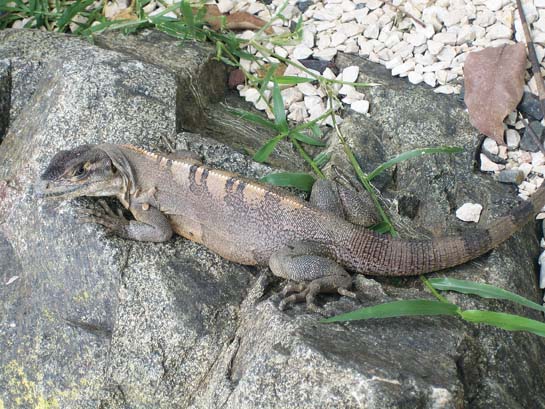
Photo by Mike Wines
Black spiny-tailed iguanas (Ctenosaura similis) were abundant, especially on the Pacific side of the country.
We flew into San José, stayed a night and left early in the morning for Lagunas del Tortuguero, an estuary in the northeast. While waiting for a bus to take us closer to our destination, we couldn’t resist looking around a little. After just two minutes of looking through brush, I found my first strawberry poison frog (Dendrobates pumilio) — and then another and another all around the same tree. The bus dropped us off along a riverbank where a boat was waiting. As we spent the next two hours slowly motoring down the river toward Lagunas del Tortuguero, we scanned the treetops and spotted several green iguanas (Iguana iguana). There was not a direction that we couldn’t see wildlife. Michelle and I barely took a breath as we pointed things out to each other. Mealy parrots and cormorants were everywhere. Turtles and caimans slipped into the water from the riverbanks, and as we got closer to the Gulf of Mexico, we saw puffer fish swimming in the slow, shallow, brackish waters.>
Jungle Sights and Sounds
When we pulled up to our destination, a resort at the river’s mouth, which drained into the Caribbean Sea, we were greeted by a pair of toucans and a group of howler monkeys congregating in the surrounding rain forest. The resort was designed to leave as small a footprint as possible with a focus on being ecofriendly. Our room was down a path lined with flora such as birds of paradise, banana plants, palms and other native species loaded with flowers bigger than my head. Blue crab burrows were everywhere, and on a plant outside of our room sat a common basilisk (Basiliscus basiliscus) cautiously sunning.
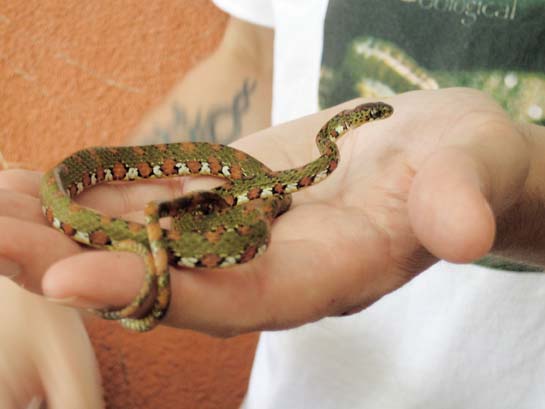
Photo by Mike Wines
This Sibon anthracops was found in the latter half of the author’s trip.
After relaxing with an Imperial, a delicious local beer, we had a couple hours of sunlight left for hiking. The air was cleaner than I had ever experienced. Although the weather was warm and humid, it was nice under the canopy of trees. Massive spider webs complete with orb weavers were everywhere. Above us in the trees we saw green iguanas reclining across the branches. The sounds of birds, monkeys, frogs and insects combined to form a tornado of noise that seemed to come in waves.
Doggone Scary
As daylight faded we made our way back for dinner. Later, we got out our flashlights for a night hike. The noises were different but just as loud. Toads the size of softballs were out. We spotted many pairs of eyes, watching us cautiously, in our flashlight beams.
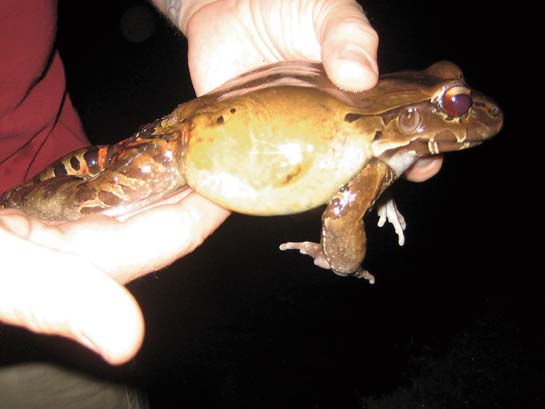
Photo by Mike Wines
Then, out of the dark a strange rustling sound came from behind us. We froze. It got louder and louder. While working with rattlesnakes all day at the Memphis Zoo, I rarely got the willies. I had them now. Suddenly, an animal exploded out of the brush behind us. Michelle practically climbed up my back. It was a beagle. That’s right. The mighty biologists exploring the deep, dark jungle of Central America were scared stupid by a cute little dog. It was the only thing that seemed out of place the whole time we were at the resort.
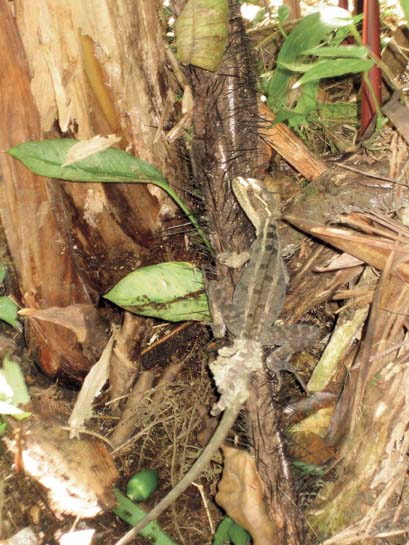
Photo by Mike Wines
What the author believes were Sphaerodactylus pacificus geckos gathered around lights to catch insects each night..
Out of respect for the forest and the people there, we didn’t flip logs or rocks, or tear bark off trees. We left everything just as we found it.
Across the River
The next day we crossed the river to explore a different area. A local guide who spoke English showed us sleeping bats wrapped up in huge palm leaves during the day and hummingbird nests built inside the tip of large, hanging leaves. Groups of howler monkeys, white-faced capuchin monkeys and spider monkeys all seemed to harass each other over food and territory. When we got too close, a group of spider monkeys bombarded us with fruit rind — I hope.

Photo by Mike Wines
Waiting for a bus, the author spotted this strawberry poison frog (Dendrobates pumilio) clustered among others on a nearby tree.
We saw everything from neon-orange fungus to bullet ants. Tiny anoles and strawberry poison frogs were everywhere. If we stood still for a few minutes, Middle American ameivas (Ameiva festiva) dragged their brilliant-blue-green tails onto the path in front of us for some sun. Later that day, another local guide took us on a boat ride down some of the smaller streams. We saw river otters swimming, herons building nests and cormorants drying their wings. Then we saw the animal that always pops into my head when I hear the word “exotic.” A huge, male green basilisk (Basiliscus plumifrons) was sunning on a branch overhanging the water. We slowly moved the boat closer, and I climbed over Michelle to get a picture. He sat there as if he were posing for the camera.

Photo by Mike Wines
The author discovered this Neotropical bird snake (Pseustes poecilonotus) eating a bird.
Onward we glided, and we saw more caimans, turtles and a yellow eyelash viper (Bothriechis schlegelii) hanging on a thin branch between trees. We stopped on the way back at the actual village of Lagunas del Tortuguero. It’s on a small island between the river on one side and the Caribbean Sea on the other. We walked the dark volcanic sand beaches where sea turtles are protected and welcomed every year. We also met a man wearing a live rhinoceros beetle. Although there was a language barrier, he was as friendly as everyone else in the country and allowed me to hold it for a picture.
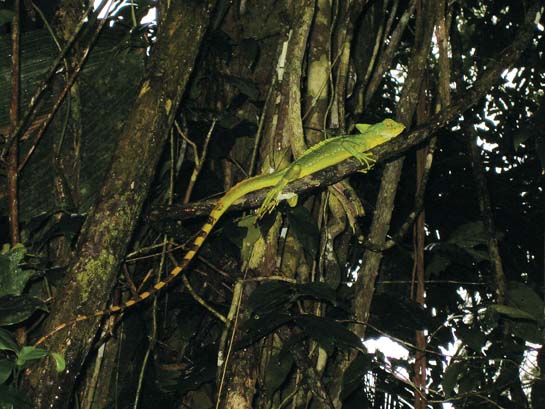
Photo by Mike Wines
A huge, male green basilisk (Basiliscus plumifrons) sunning on a branch.
I suggested a canopy tour to Michelle, but I soon learned my bride was terrified of heights. However, she did eventually acquiesce, and it was well worth it. We climbed 200 feet up into the canopy and rode wires from tree to tree to get another perspective of the world I had dreamt about for so many years. In the end, the trip was a tremendous experience, and I’d recommend it to anyone looking for a great herp adventure.
MIKE WINES worked at the Memphis Zoo with venomous reptiles, including the Komodo dragon, for more than five years. While there he developed a live venomous snake show, which staff members still present. Still part of the zoo’s research department, he has since moved to Alabama. Wines has worked with and bred countless reptile species during the past 15 years.



